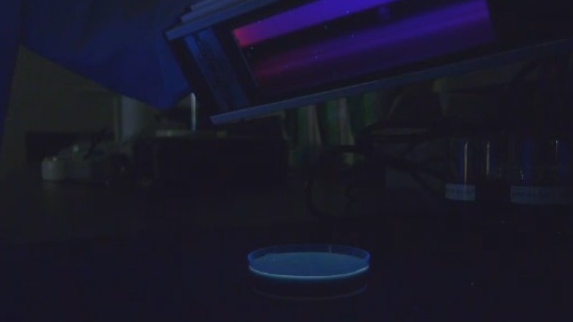Real deal or sneaky swap? Ontario researchers working on tool to test maple syrup purity
Real maple syrup can be pricey, so it’s no surprise that some people might try and swap it out for a cheaper version.
Production of this so-called ‘liquid gold’ can be impacted by weather fluctuations and production quotas. There have also been cases of smuggling and mislabeling product, as well as the 2016 theft of 9,500 barrels of maple syrup from a Quebec warehouse often referred to as the “Great Canadian Maple Syrup Heist.”
Less than honest operators are known to mix genuine maple syrup with other syrups or sweeteners.
“Corn syrup is one-tenth the value of maple syrup,” says Maria Corradini, an associate professor at the University of Guelph.
Researchers in the school’s Department of Food Science and Department of Integrative Biology are hoping they can help producers – and consumers – by creating a rapid testing tool that can identify whether the sweet stuff is the real deal.
THE SCIENCE
Researchers are using something called fluorescence fingerprinting.
Certain molecules in the maple syrup glow when exposed to UV and visible light. Those can be analyzed to determine – and create a 3D map – of their chemical composition.
 Maple syrup samples being tested for purity at the University of Guelph. (Spencer Turcotte/CTV Kitchener)
Maple syrup samples being tested for purity at the University of Guelph. (Spencer Turcotte/CTV Kitchener)
“This method can potentially be used to differentiate between pure maple syrup and potentially adulterated maple syrup,” explains Maleeka Singh, a food science PhD candidate.
Researchers say they can detect adulterants even in quantities as low as one per cent.
Other fingerprinting techniques, such as DNA barcoding, aren’t compatible with maple syrup testing.
Sap undergoes extensive processing to transform it into syrup and that can cause its DNA to degrade, say the researchers.
They also point out that a light-based tool is “non-invasive, efficient and affordable,” and results can be obtained within minutes.
 Researchers using UV light to test the purity of maple syrup samples at the University of Guelph. (Spencer Turcotte/CTV Kitchener)
Researchers using UV light to test the purity of maple syrup samples at the University of Guelph. (Spencer Turcotte/CTV Kitchener)
SYRUP PRODUCER REACTION
Wally Sallans, the owner of Maple Tap Farm in New Dundee, Ont., started making maple syrup at the age of 14. He recently wrapped up another tree tapping season, and says making ‘liquid gold’ takes a lot of work.
“It’s about 40 to one usually, what you have to boil,” Sallans explains. “Take 40 gallons of water out to get a gallon of syrup.”
He knows that some people try to trick the system.
“It doesn’t make you feel good that somebody is trying to duplicate it and make something that isn’t the pure product,” Sallans says. “To be legally maple syrup it has to be at least 66 BRIX, which is like 66 per cent sugar.”
 Wally Sallans, the owner of Maple Tap Farm, in New Dundee, Ont. (Spencer Turcotte/CTV Kitchener)
Wally Sallans, the owner of Maple Tap Farm, in New Dundee, Ont. (Spencer Turcotte/CTV Kitchener)
University of Guelph researchers say they’re close to solving this sticky situation.
“What is more Canadian than maple syrup?” Singh says. “I really think this type of research can really impact Canada’s product image.”
CTVNews.ca Top Stories

Trudeau considering his options as leader after Freeland quits cabinet, sources say
Chrystia Freeland, Canada's finance minister, said in an explosive letter published Monday morning that she will quit cabinet. Here's what happened on Monday, Dec. 16.
'We're not united': Liberal caucus meets, as PM Trudeau faces fresh calls to resign in light of Freeland's departure
The federal Liberals called an emergency caucus meeting Monday night, as Prime Minister Justin Trudeau faced renewed calls from some members of his party to resign. As MPs emerged, the message was mixed.
'Eventful day,' Trudeau says after Chrystia Freeland quits cabinet, LeBlanc tapped to replace her
In a stunning move, Deputy Prime Minister and Finance Minister Chrystia Freeland announced her resignation from Justin Trudeau's cabinet on Monday, after the prime minister told her he no longer wanted her in the top economic post. After hours of turmoil, Dominic LeBlanc, was sworn-in as her replacement in the finance portfolio.
Feds deliver fall economic statement with $61.9B deficit for 2023-24, amid political turmoil
Amid the news that Chrystia Freeland has resigned from her cabinet position as finance minister, the Department of Finance on Monday unveiled the long-anticipated fall economic statement, which reports a deficit of $61.9-billion for 2023-24.
W5 Investigates Connecting the dots on a landlord scam: how clues revealed a prolific con artist at work
In part one of a three-part investigation, W5 correspondent Jon Woodward reveals how a convicted con artist bilked dozens of people in a landlord scam.
Judge rules Trump does not have presidential immunity protections in hush money conviction
Donald Trump's felony conviction in the New York hush money case should not be tossed out because of the Supreme Court's ruling on presidential immunity.
Canadian hero Terry Fox being featured on next $5 bill
The federal government is paying tribute to Canadian hero Terry Fox by featuring him on the next $5 bank note, officials revealed Monday.
Wisconsin school shooter who killed teacher, student was 17-year-old girl, police say
A teenage student opened fire with a handgun Monday at a Christian school in Wisconsin, killing a teacher and another teenager during the final week before Christmas break. The shooter also died, police said.
Travel risk: Which countries does Canada recommend avoiding?
Canadians planning to travel abroad over the holidays should take precautionary steps to ensure they're not unintentionally putting themselves in harm's way.































